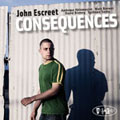Building Bridges With a Post-Bop Ideal
John Escreet began his first set at the Jazz Gallery on Thursday night with a solo piano rumination, soft but stern. He was playing “No Doubt,” by the pianist-composer Andrew Hill, as an invocation, and maybe a stylistic pledge of allegiance. But then when he struck up a tempo to cue his band, the theme it hammered out was a choppy thing called “Unison,” by the British saxophonist Jason Yarde.
That juxtaposition says something about Mr. Escreet, who moved to New York from England a few years ago. Now in his mid-20s, he approaches music with a broad perspective and a knack for drawing connections. Mr. Hill, who died in 2007, can be a touchstone for him, but so can Mr. Yarde, who’s closer to his age and scarcely known on this side of the Atlantic. It all feeds a purpose of dynamic abstraction, the progressive post-bop ideal.
Mr. Escreet recently released his first album, “Consequences” (Posi-Tone), featuring a New York group he calls the John Escreet Project: the alto saxophonist David Binney, the trumpeter Ambrose Akinmusire, the bassist Matt Brewer and the drummer Tyshawn Sorey. Here, with Zack Lober substituting for Mr. Brewer, the band was both elastic and fervent.
In the spirit of Mr. Hill — and Jason Moran, with whom he has studied — Mr. Escreet wants his performances to feel sudden and changeable. His solo on “Unison” was one long crescendo, all stuttering rumble and cresting tide. Mr. Binney, up next, ordered a breakneck swing tempo, his notes forming gusty arcs. When it was Mr. Akinmusire’s turn, the band fell away, leaving him space for a pointillist concerto.
The episodic strategy for the band flattered no one more than Mr. Akinmusire, an expert colorist with imposing technique. He delivered the most striking solo of the set on an Escreet original called “Dilemma,” flirting with free improvisation but keeping a toehold in melody. Even at his most texture-minded, with whinnies and slurs, he made sense.
The same was true later, when he made his trumpet evoke a sputtering turbine on “Wayne’s World,” another piece by Mr. Escreet (named for Wayne Shorter, not the movie). This time he wasn’t alone: Mr. Binney, hissing through his reed, and Mr. Sorey, thumping his bass drum with a mallet, helped stir the air. They paused only for a dash of pianism by Mr. Escreet, who treated it as a transition, another bridge to build.
